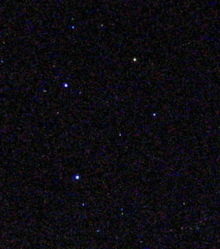New stars found in Southern Cross
Thursday, February 8, 2007

New stars have been recently discovered in the Southern Cross, or Crux, by scientists in the United States. This discovery could affect the flags of New Zealand, Australia, Papua New Guinea, Samoa and Brazil, although the new star is located very close to the westernmost star and invisible to the naked eye.
The American scientists found the new stars in the Southern Cross by using the Chandra X-ray Observatory, a space satellite run by NASA (National Aeronautics and Space Administration) which uses x-rays.
When the scientist team, led by David Cohen of Swarthmore College in Pennsylvania, were using the Chandra telescope, they, to their surprise, saw two x-ray glows, each representing stars, where they expected to see one. The new star appears to be orbiting Beta Crucis, the westernmost star in the Southern Cross, once every 2,000 years. Doctor Nick Lomb, an astronomer at the Powerhouse Museum, Sydney, Australia, said that the reason the star had not been found before was because the glare from Beta Crucis is too great and "It would be like looking for a glow worm next to a floodlight." Before the recent discovery, it was already known that Beta Crucis had a partner, which is invisible to the human-eye.
Mr Cohen said that they found it by accident, as they were really trying to get information about the x-rays emitted by Beta Crucis. "We were interested in how the highly supersonic stellar winds of hot, luminous stars produce X-rays."
The star found at the bottom of the Southern Cross, Alpha Crucis "Acrux", also has a partner star, which is also invisible to the human-eye. This invisible partner is not featured on any flags.
Dr Lomb said the apparent separation between each star is like looking at two headlights from 100 kilometres away, even though the two stars are actually 60 billion kilometres away from each other.
Dr Lomb said that if Australia was to put all eight stars in the Southern Cross onto the Australia flag then "the flag would have to be huge, probably the size of Sydney." Astronomer Alan Gilmore from University of Canterbury's Mount John observatory, also agreed that flags should not be altered because it is not about how many stars there are in the Southern Cross, but the magnitude of the stars. Mr Gilmore said: "What you see by eye is what you see on the flag. If you wanted to add more stars, there's no end of stars you can put on if you go down in order of brightness. It would get very confusing."
Mr Gilmore has said that in 20,000 years that Southern Cross will be different anyway, because the top star, Gamma Crucis is 90 light years away from Earth, while Alpha Crucis, Beta Crucis and Delta Crucis are all around 350 light years away and they are all moving in different directions. And Dr Lomb said that Alpha, Beta and Delta Crucis will die in a few million years.
These findings were presented to the American Astronomical Society, Seattle, Washington, by an undergraduate of Mr Cohen's team, Michael Kuhn.
-
Flag of New Zealand.
-
Flag of Australia.
-
Flag of Papua New Guinea.
-
Flag of Samoa.
-
Flag of Brazil.
Sources
- "Flag concern over new Southern Cross stars" — The Press, February 8, 2007
- Benjamin Lester. "Stellar discovery ruins Aussie flag" — Cosmos Online, February 7, 2007
- Richard Macey. "Flag falls short as new star is born" — The Sydney Morning Herald, February 7, 2007








